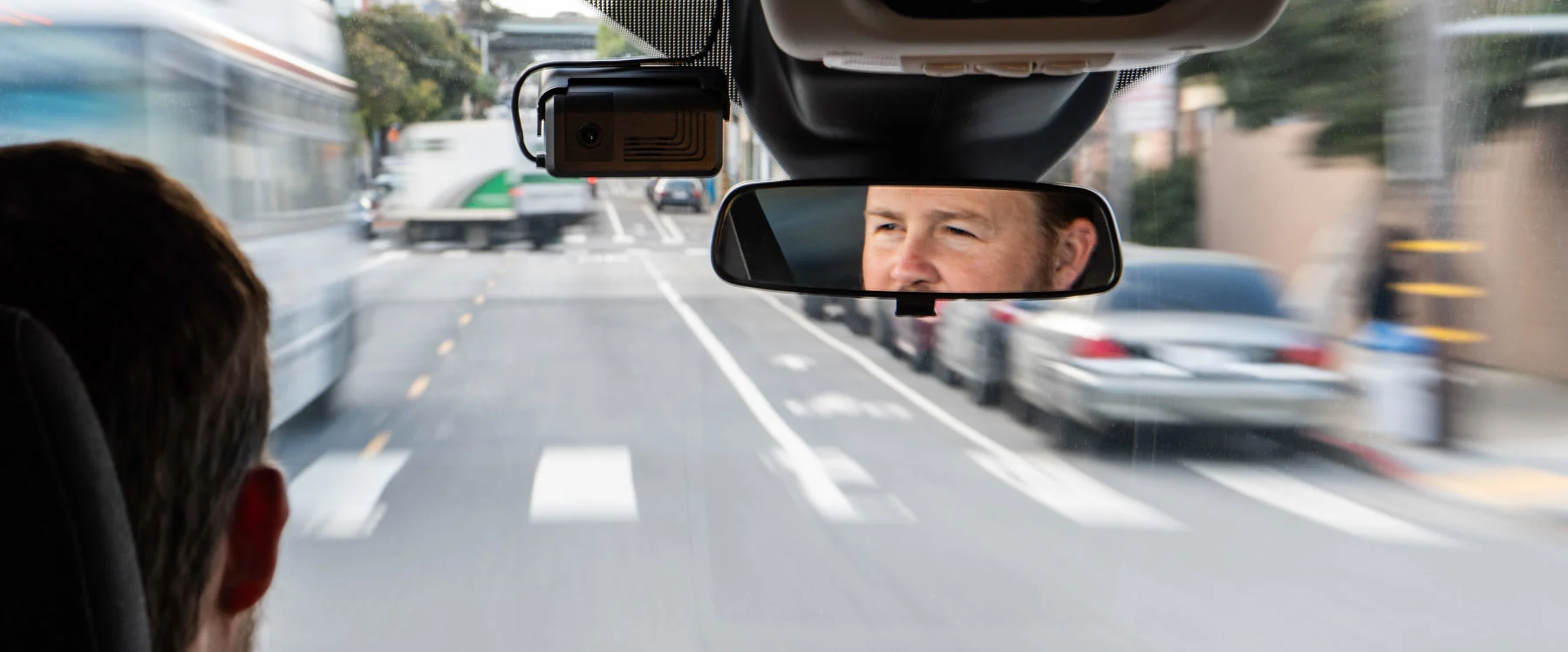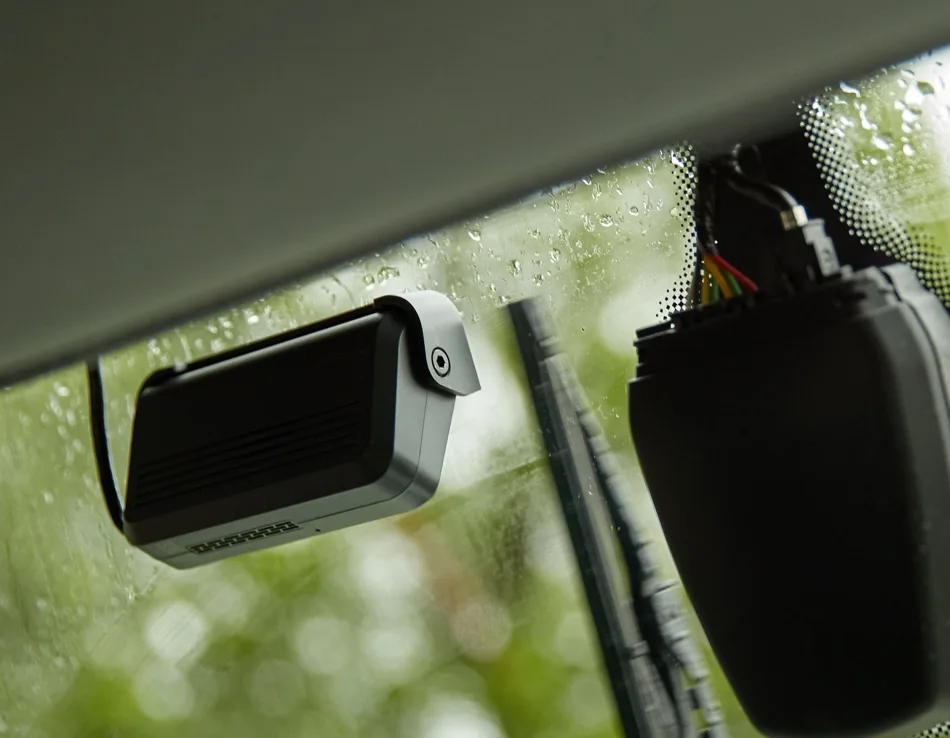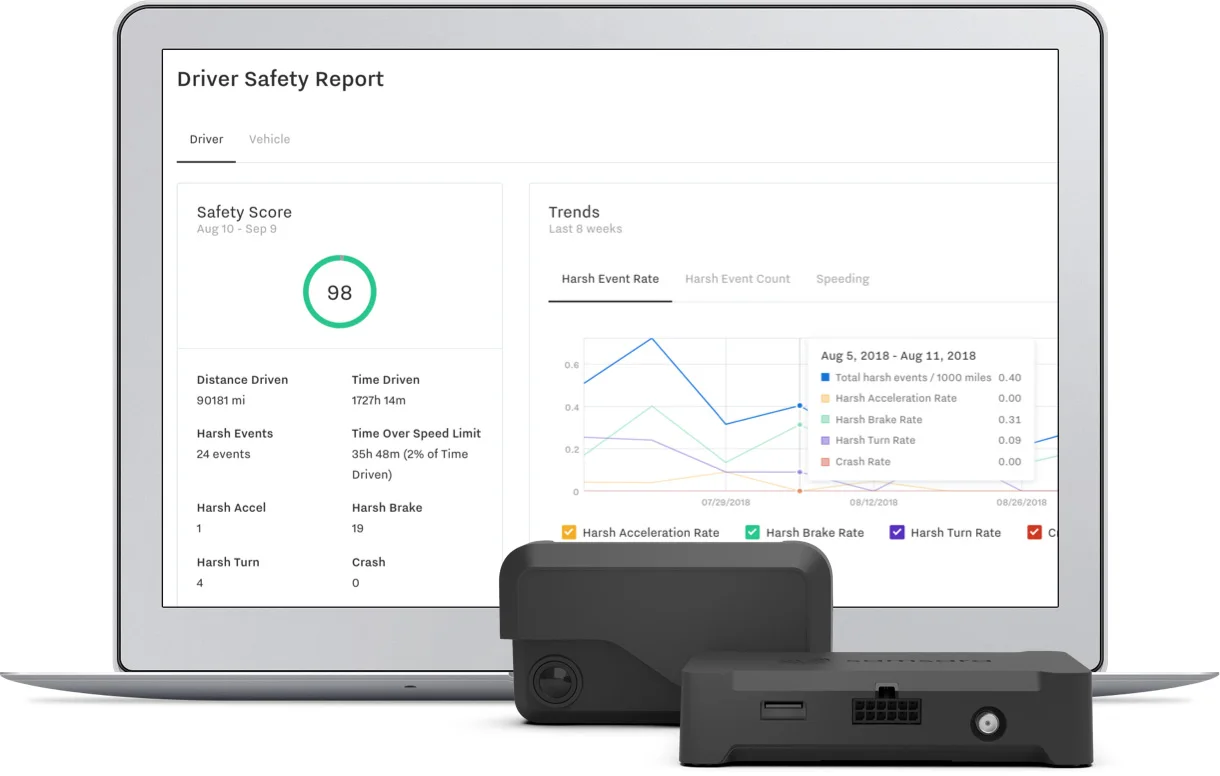Why invest in dash cams?
If you manage a fleet of vehicles and haven’t invested in dash cams yet, now might be the time. Dash cams enable a robust fleet safety program and drive measurable ROI for your business.
If you manage a fleet of vehicles and haven’t invested in dash cams yet, now might be the time. Dash cams enable a robust fleet safety program and drive measurable ROI for your business.
of commercial crashes are due to avoidable driver error
decrease in collision frequency when dash cams are used
decrease in accident-related costs when dash cams are used


Dash cams, also known as dash cameras or dashboard cameras, are an extremely effective safety tool for commercial fleets. From coaching drivers to exonerating your company from false claims, they can be used in a variety of ways to improve fleet safety and reduce costs
Dash cams are cameras that can be installed in a vehicle to capture footage of the road ahead and activity inside the cab. The best dash cams are connected to a telematics solution with built-in GPS and a g-sensor, so the system can automatically detect safety-related events—like harsh braking, harsh turning, and collisions—and upload incident footage to the cloud. There are a variety of different types of dash cams that can be deployed for various purposes, but generally fleets install dash cams because they’re looking for better visibility into on-the-road safety, the ability to coach drivers in real time, and footage that they can use to exonerate innocent drivers in case of an accident.
One of the biggest objections to investing in dash cams is the cost. Although the initial cost of dash cams might seem expensive, video-based safety solutions have been proven to reduce overall fleet operating costs and quickly pay for themselves. In fact, the NSTSCE found that when combined with driver coaching, dash cams reduced safety-related events by 52%.
Learn more about the ROI of dash cams
See how much money your fleet could save by rolling out a video-based safety solution.
Learn MoreBefore diving into the different types of dash cams, it’s important to take a step back and understand why commercial fleets are investing in this technology. Below, check out the four major benefits of dash cams.
Dash cams aren’t one-size-fits-all. There are a variety of different types of dash cams available which offer varying specs and functionality—but some are better suited for commercial fleets than others.
If you Google "dash cams," you're likely to find dash cams meant for consumers on websites like Amazon. Some of the most popular consumer dash cam brands include Sony, Thinkware, Vantrue, Viofo, Nextbase, BlackVue, and Garmin dash cams. While these are top picks for enthusiasts looking to install an inexpensive camera in their personal vehicle, they’re not meant for commercial fleets. They usually have a memory card that must be manually retrieved to download footage, posing logistical challenges for fleets managing multiple vehicles and drivers.
Dash cams for commercial fleets are more robust—both in terms of the features they offer and the value they can provide. Dash cams that are purpose-built for commercial fleets, like Samsara AI Dash Cams, connect to a telematics device that provides WiFi and can detect safety-related events like harsh braking, speeding, and collisions. That way, these dash cams can auto-upload video footage from safety-related events to the cloud, making it easy for your back-office staff to review safety-related events and coach drivers effectively.
Once you decide what configuration best fits your needs, you’ll also want to consider the variety of different features available. From artificial intelligence (AI) to night vision, here are a few of the most important dash cam system features to consider.

Artificial intelligence: The most advanced dash cam systems include built-in artificial intelligence (AI), so they can detect safety issues without a g-force trigger—like distracted driving and drowsiness. AI makes it possible to coach drivers on risky behavior and near misses.

Internet connectivity: Most dash cam systems have a micro SD card or memory card that stores footage locally, but more advanced dash cam systems can connect to the internet via high-speed cellular connections that let you send footage to the cloud, providing nearly instant access to footage. Some internet-connected dash cams even provide advanced features like parking mode, which allow the dash cam to continue recording for a period of time after a trip ends.

Harsh event detection: The best dash cam systems connect to a telematics device with a built-in gyroscope and accelerometer to automatically detect harsh driving events—like harsh braking or a collision—and auto-upload footage to the cloud.

Resolution: Resolution (or image quality) depends on how many pixels the dash cam system records. High quality forward-facing dash cam systems should record video in high-resolution 1080p full HD. 1080p dash cams make it possible for you to see the road ahead clearly and make out numbers on license plates.

Field of view: Field of view is how much of the road (or inside of the cab) the dash cam system can see. To ensure your dash cam system captures a broad field of view, look for a wide angle or semi-wide angle lens.
Mounting: The two most popular ways to install dash cam systems are via a suction cup (or suction mount) or via adhesive. Some dash cam systems may also attach to your rear view mirror. Adhesive attachments are generally a more secure option that still offer quick and easy installation.

Audio speaker and recording: Some dash cam systems include built-in speakers that can play verbal and/or audio alerts when unsafe driving behavior is detected, like mobile phone use, speeding, and drowsiness. You may also be able to turn on recording to capture audio during safety events.

Night vision: Some dash cam systems are optimized for capturing footage at night or in low-light conditions. If your drivers often operate at night, look for a dash cam system with infrared LED, which is particularly important for capturing video footage of unlit cabs.

of Samsara dash cam customers have exonerated a driver in the past year
of customers say Samsara has improved safety within their fleet
learn moreWith so many dash cam vendors on the market, it’s impossible to try every single option. How can you narrow it down? Here are a few things to consider when selecting the best dash cam solution that will be worth it for your fleet.
Internet connectivity is key for any fleet that wants to use dash cams as a proactive safety tool. Without internet connectivity, dash cams can only store footage on a local memory card—meaning someone has to manually retrieve the footage from the vehicle. On the other hand, dash cams that are connected to a telematics device with WiFi and cell service can auto-upload event footage to the cloud. This makes it possible for fleet managers to coach and exonerate drivers in real time.
When evaluating dash cam solutions, look for an integrated platform that offers dash cams and connected driver and admin apps in one, unified solution. Why? Beyond consolidating your tools and simplifying your workflows, an all-in-one platform connects the dots between your data, unlocking better insights and larger safety improvements.
By integrating AI Dash Cams, telematics, and cloud-based software, Samsara’s Video-Based Safety solution helps fleets make measurable safety improvements and provides ROI in the moments that matter. In a survey of more than 500 Samsara customers, 90% said Samsara’s Video-Based Safety solution has helped improve safety within their fleet. And many Samsara customers across both the private and public sector, such as the City of Allentown, have saved $1 million or more through their safety programs with Samsara.
Currently evaluating dash cam solutions? Request a free trial of Samsara today to see how an all-in-one platform can improve the safety of your fleet.

Advanced incident detection

Auto-uploaded event footage

Streamlined coaching tools

Driver safety scores

Analytics & trend reports

Fewer tools to switch between

Learn how Samsara can help you implement a successful fleet safety program from start to finish. This step-by-step change management guide includes implementation best practices, easy-to-follow checklists, safety policy recommendations, and success stories from Samsara customers.
Get your guideSamsara offers an all-in-one platform for improving fleet safety, empowering drivers, and reducing costs.



